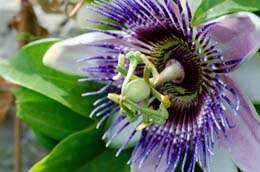Known for the striking purple color of its flowers, the purple passion plant is a hardy vine that grows in southern parts of North America.

The purple passion plant or
Passiflora Incarnata is a fast growing, perennial plant that is commonly found in the southern parts of the United States. Although it's a wild plant, it is also found in gardens growing as exotic houseplants. It is one of the hardiest species of the passion flower group.
Physical Characteristics
This plant has long and trailing stems that bear many tendrils. Stems can be pubescent or smooth that bear palmate leaves with 3 lobes. The leaves have an alternate arrangement over the stem.
Purple passion flowers have a characteristic bluish white petals. The plant gets its name from a comparison of its flowers with the elements of the crucifixion of Christ. The flower has five petals and sepals each of which are compared to the 10 apostles of Christ (excluding Judas and Peter). The 3 styles are believed to symbolize the nails of Christ's cross and the stemmed ovary is compared to the Lord's Goblet. The 5 stamens of the flower is believed to represent Christ's 5 wounds, whereas the filament located at the top of the flower is considered to symbolize the Crown of Thorns placed on Jesus' head.
The purple passion bears oval, yellowish, fleshy fruits that are about the size of a hen's egg. Also known as
Maypop, the fruit is initially green. However, as it matures, it takes on a yellow color.
Growth
Purple passions can be grown as a houseplant, or as an annual in the garden. It will thrive in either condition. Propagating these plants is very easy, specially when it is pruned. Just take the cuttings, that should be 3-5 inches in height, and bury them in the soil. Water it frequently.
Sunlight: These plants require bright sunlight which helps them to maintain their characteristic purple color. However, very strong sunlight can be damaging to the plant. Hence, if grown inside, plant the vine in an east or west window or in a south window covered with a transparent curtain. If you are growing it outside, provide partial shade to it. Take special care that it is well protected from the scorching heat of the afternoon sun.
Soil and Water Requirements: This plant prefers moist soil. They grow well in soil which has 50% peat moss added to it. If the plant is grown as an outdoor plant, it should be watered everyday. However, when grown inside, adding water to the soil once a week would meet its water requirements.
Trimming: One important aspect of this plant while growing it in the garden is trimming. Trimming the ends of the stem will ensure that the plant bears a full look.
Uses
Although the fruit is edible, other parts of the plant may be toxic. The juicy fruit makes a delicious but seedy snack. The pulp that clings to the black seeds are used for making jellies, pies, syrups, ice cream puddings, and cakes. Traditionally, the fruit was very popular among the settlers of the South as well as the Native American tribes.
Recent studies have shown that this plant contains flavonoids that help in bringing a calming and relaxing effect. This has made this plant useful for treating anxiety symptoms and insomnia.






 The purple passion plant or Passiflora Incarnata is a fast growing, perennial plant that is commonly found in the southern parts of the United States. Although it's a wild plant, it is also found in gardens growing as exotic houseplants. It is one of the hardiest species of the passion flower group.
The purple passion plant or Passiflora Incarnata is a fast growing, perennial plant that is commonly found in the southern parts of the United States. Although it's a wild plant, it is also found in gardens growing as exotic houseplants. It is one of the hardiest species of the passion flower group.